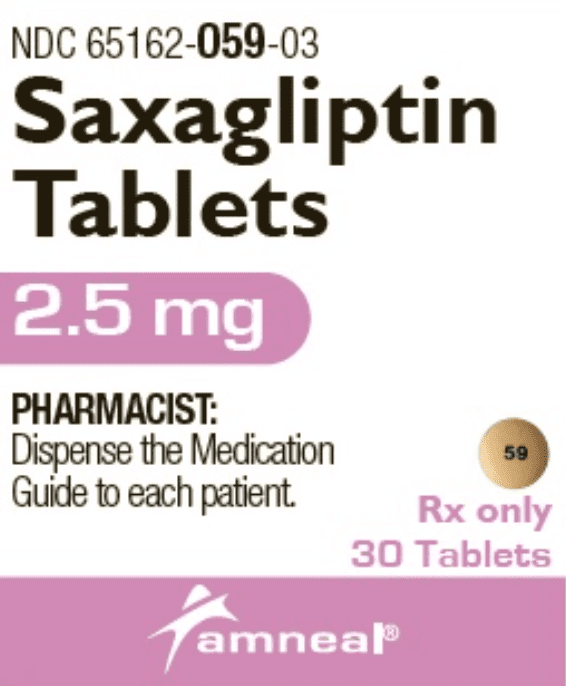Saxagliptin
Generic name: saxagliptin [ SAX-a-GLIP-tin ]
Brand name: Onglyza
Dosage form: oral tablet (2.5 mg; 5 mg)
Drug class: Dipeptidyl peptidase 4 inhibitors
What is saxagliptin?
Saxagliptin is used together with diet and exercise to improve blood sugar control in adults with type 2 diabetes mellitus. Saxagliptin is not for treating type 1 diabetes.
Saxagliptin is sometimes used in combination with other diabetes medications.
Saxagliptin may also be used for purposes not listed in this medication guide.
Saxagliptin side effects
Get emergency medical help if you have signs of an allergic reaction: hives, a purple or red skin rash that spreads and causes blistering and peeling; difficulty breathing; swelling of your face, lips, tongue, or throat.
Stop taking saxagliptin and call your doctor right away if you have symptoms of pancreatitis: severe pain in your upper stomach spreading to your back, nausea and vomiting, loss of appetite, or fast heartbeats.
Saxagliptin may cause serious side effects. Call your doctor at once if you have:
-
severe or ongoing pain in your joints;
-
pain or burning when you urinate; or
-
heart problems--shortness of breath (even while lying down), feeling weak or tired, rapid weight gain, swelling (especially in your feet, legs, or midsection.
Common side effects of saxagliptin may include:
-
painful urination;
-
headache;
-
runny or stuffy nose, sore throat, cough; or
-
swelling in your hands or feet.
This is not a complete list of side effects and others may occur. Call your doctor for medical advice about side effects. You may report side effects to FDA at 1-800-FDA-1088.
Warnings
You should not use saxagliptin if you are in a state of diabetic ketoacidosis (call your doctor for treatment with insulin).
Saxagliptin is not for treating type 1 diabetes.
Before taking this medicine
You should not use this medicine if you have ever had a severe allergic reaction to saxagliptin, or if you are in a state of diabetic ketoacidosis (call your doctor for treatment).
Tell your doctor if you have ever had:
-
kidney disease (or if you are on dialysis);
-
high triglycerides (a type of fat in the blood); or
Follow your doctor's instructions about using this medicine if you are pregnant or you become pregnant. Controlling diabetes is very important during pregnancy, and having high blood sugar may cause complications in both the mother and the baby.
It may not be safe to breastfeed while using this medicine. Ask your doctor about any risk.
Saxagliptin is not approved for use by anyone younger than 18 years old.
How should I take saxagliptin?
Follow all directions on your prescription label and read all medication guides or instruction sheets. Your doctor may occasionally change your dose. Use the medicine exactly as directed.
You may take saxagliptin with or without food. Follow your doctor's instructions.
Swallow the tablet whole and do not crush, chew, or break it.
Your blood sugar will need to be checked often, and you may need other blood tests at your doctor's office.
You may have low blood sugar (hypoglycemia) and feel very hungry, dizzy, irritable, confused, anxious, or shaky. To quickly treat hypoglycemia, eat or drink a fast-acting source of sugar (fruit juice, hard candy, crackers, raisins, or non-diet soda).
Your doctor may prescribe a glucagon injection kit in case you have severe hypoglycemia. Be sure your family or close friends know how to give you this injection in an emergency.
Blood sugar levels can be affected by stress, illness, surgery, exercise, alcohol use, or skipping meals. Ask your doctor before changing your dose or medication schedule.
Saxagliptin is only part of a complete treatment program that may also include diet, exercise, weight control, blood sugar testing, and special medical care. Follow your doctor's instructions very closely.
Store at room temperature away from moisture and heat
Saxagliptin dosing information
Usual Adult Dose for Diabetes Type 2:
2.5 or 5 mg orally once a day, regardless of meals
Coadministration with strong CYP450 3A4/5 inhibitors: 2.5 mg orally once a day
Use: Adjunct to diet and exercise to improve glycemic control in adults with type 2 diabetes in multiple clinical settings
What happens if I miss a dose?
Skip the missed dose and take your next dose at the regular time, unless your doctor tells you otherwise. Do not take two doses at one time, and do not take an extra dose the next day.
What happens if I overdose?
Seek emergency medical attention or call the Poison Help line at 1-800-222-1222. You may have signs of low blood sugar, such as extreme weakness, confusion, tremors, sweating, fast heart rate, trouble speaking, nausea, vomiting, rapid breathing, fainting, and seizure (convulsions).
What should I avoid while taking saxagliptin?
Follow your doctor's instructions about any restrictions on food, beverages, or activity.
What other drugs will affect saxagliptin?
Other drugs may increase or decrease the effects of saxagliptin on lowering your blood sugar. Tell your doctor about all medications you use. This includes prescription and over-the-counter medicines, vitamins, and herbal products. Not all possible interactions are listed in this medication guide.
Frequently asked questions
More about saxagliptin
- Check interactions
- Compare alternatives
- Pricing & coupons
- Reviews (16)
- Drug images
- Side effects
- Dosage information
- During pregnancy
- Drug class: dipeptidyl peptidase 4 inhibitors
- Breastfeeding
- En español
Patient resources
Other brands
Professional resources
Other brands
Related treatment guides
Further information
Remember, keep this and all other medicines out of the reach of children, never share your medicines with others, and use this medication only for the indication prescribed.
Always consult your healthcare provider to ensure the information displayed on this page applies to your personal circumstances.
Copyright 1996-2024 Cerner Multum, Inc. Version: 8.02.

